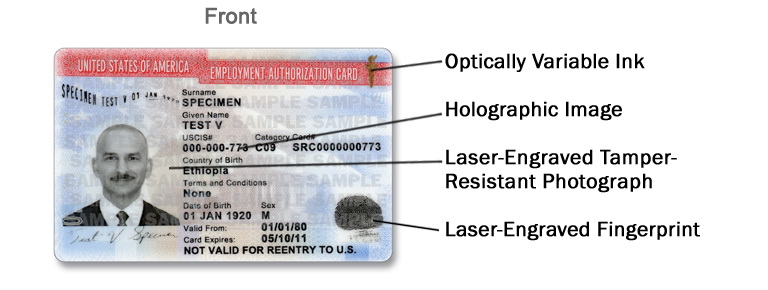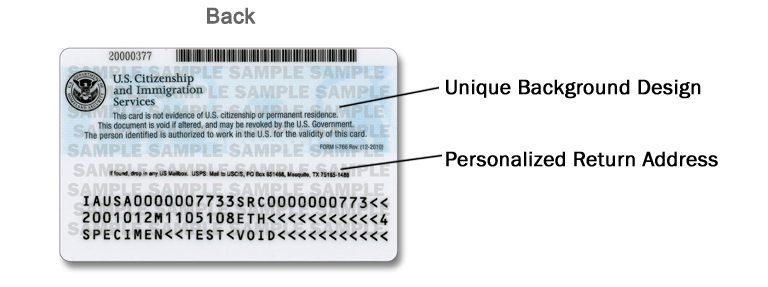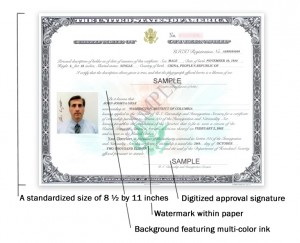USCIS Redesigns Employment Authorization Document and Certificate of Citizenship to Enhance Security and Combat Fraud
State-of-the-art technology will deter counterfeiting, obstruct tampering, and facilitate quick and accurate authentication.
WASHINGTON - U.S. Citizenship and Immigration Services (USCIS) Director Alejandro Mayorkas today announced the launch of an enhanced Employment Authorization Document (EAD) and a redesigned Certificate of Citizenship (Form N-560) with new features to strengthen security and deter fraud.
Additionally, USCIS employs a new and more secure printing process for its redesigned Certificate of Citizenship that renders the certificate more tamper-proof.
Although the look and feel of the documents is new, the manner in which an applicant applies for and receives them will not change. USCIS will replace EADs already in circulation as individuals apply for their renewal or replacement. All previously issued EADs remain valid until the expiration date printed on the card. Previously issued Certificates of Citizenship remain valid indefinitely.
These improvements demonstrate USCIS’s ongoing efforts to produce more secure documentation. In 2010, USCIS issued the new Permanent Resident Card, which added security features to the physical card and integrated technology improvements in the card production process. Additionally, USCIS launched the redesigned Certificate of Naturalization (Form N-550) featuring the naturalization candidate’s digitized photo and signature embedded into the document. USCIS will continue to enhance document security features as technology improves.
The United States Citizenship and Immigration Services (USCIS) announced this week that the agency is now issuing an enhanced Employment Authorization Document (EAD) and a redesigned Certificate of Citizenship (Form N-560) with new features to strengthen security and deter fraud. According to the alert, the state-of-the-art technology incorporated into the new documents will deter counterfeiting, obstruct tampering, and facilitate quick and accurate authentication (where required). Let’s take a quick look at the new (and improved) documents.
The Employment Authorization Document (Form I-766)
The USCIS worked closely with the Immigration and Customs Enforcement Forensic Document Laboratory to incorporate technology and tactile features, which will better equip workers, employers and law enforcement officials to recognize the EAD as definitive proof of work authorization (for certain qualifying foreign nationals). The USCIS began issuing the new EAD cards on October 25, 2011, and the agency will replace EADs already in circulation as individuals apply for their renewal or replacement. It’s important to note that all previously issued EADs remain valid until the expiration date printed on the card.
Features of Note
- The card number is now listed on the front of the card and depicts the alien registration number without the initial letter “A.” In addition, the front of the card also includes the case number, which reflects the case receipt number.
- Redesign results from extensive collaboration with the Immigration and Customs Enforcement Forensic Document Laboratory.
- Fine-line artwork and complex multi-layered card components that are difficult to reproduce.
- Card design and personalized features are integrated to deter fraud.
The Certificate of Citizenship (Form N-560)
The Certificate of Citizenship is issued to individuals who have: 1) derived citizenship through parental naturalization; 2) acquired citizenship at birth abroad through a United States parent or parents; or 3) acquired citizenship through application by United States citizen adoptive parent(s); and who, pursuant to section 341 of the Act, have applied for a certificate of citizenship.
Features of Note
- The new method of producing certificates will rely on a printing process that is more tamper and fraud resistant than the previous printing methods.
- The redesigned certificate will have the updated physical security features making it less susceptible to fraud.
- The new method of producing certificates is less labor intensive, less prone to human error and more secure.
How does this affect the Form I-9 Process?
The EAD
In the I-9 context, the EAD (or Form I-766) is an acceptable List A document, which establishes both identity and work authorization for qualifying foreign nationals (for a complete list of eligibility categories, please see the Form I-765 instructions here). So employers with I-9 responsibilities should take a few moments to check out the look of the new card. It’s important to remember though that employers are not required to become “document experts” in their I-9 duties, but rather simply need to ensure that the documents reasonably appear to be genuine and relate to the person presenting them. For those employers which have adopted more stringent document review standards, it would be wise to note this change and keep it with other document guides, such as the back of the I-9 Handbook (M-274) and the Guide to Selected US Travel and Identity Documents (M-396).
Employers should also remember that the EAD is evidence of “temporary” work authorization, which means it expires at some point in time. Before that expiration occurs, employers need to reverify the employee’s continuing eligibility to the work in the U.S. (using Section 3 of the form or by completing a new form) in order to avoid penalties and other more serious issues. Most employers storing pen and paper I-9s will utilize a ticker or calendar system for reminders, while those with electronic I-9 systems enjoy automatic email reminders, dashboard prompts, and reverification reports on demand.
The EAD is also noteworthy for employers participating in E-Verify, since it is one of three documents which must be photocopied and retained by the employer during the I-9 process for purposes of E-Verify photo matching (the I-551 green card and US Passport are the other two documents).
The Certificate of Citizenship
While the new certificate of citizenship includes additional protections against fraud and tampering, it is currently not on the list of acceptable I-9 documents. For many years, the certificate of citizenship had been an acceptable List A document (showing both identity and work authorization), but it was removed from the list in November 2007 (starting with the 06/05/07 version of the Form I-9). While it certainly is possible that the document may be added back in the future, employers are advised not to accept the Certificate of Citizenship as a List A document until such change is made.
In the meantime, employers may consider accepting the certificate as a “List C” document under the catch-all “Employment Authorization Document Issued by the Department of Homeland Security” as long as the employee also presents a separate identity document to record in List B. The USCIS has recently suggested this practice on their I-9 central web site here (bottom of page). As always, it’s best to discuss such I-9 practice and procedure with your own counsel before making changes to your policies.
About The Author
John Fay is an experienced corporate immigration attorney and I-9/E-Verify blogger with a unique background in designing and advising on case management technology. While practicing immigration in New York City, John designed and managed his firm’s proprietary web-based immigration management system, which featured a fully multilingual interface for international organizations. In his current role, John serves as Vice President of Products and Services and General Counsel at LawLogix, where he is responsible for overseeing product design and functionality while ensuring compliance with rapidly changing immigration rules.



